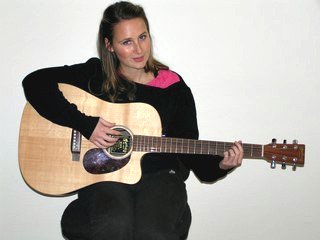Recording Acoustic Guitars

Recording Acoustic Guitars is easy, all you have to do is plug a microphone into a recorder, place the microphone in front of the acoustic guitar, press recorder and start playing.
Its that easy and you might get a good recording but, there are things you can do to get better recordings.
Just by changing the position of the microphone in relation to the guitar will have an affect on the way the acoustic guitar recording will sound.
And, by using a different type of microphone will affect the sound of the guitar recording.
Here are a few things you can try, but, just remember, one way isn't necessarily better than another, you will just get a different result. So it's important to experiment until you get the sound that you like.
One important thing is your guitar needs to be in tune so it's best to use a guitar tuner to keep it in tune.
Try using different Microphone Types
- A dynamic microphone might not be the best to use as they don't have a wide frequency response but you might get the sound you like using a dynamic microphone.
- Ribbon microphones can produce a very warm sound but they are more expensive and more delicate then other types so are easily damaged.
- Condenser microphones can produce a warm full sound but a small diaphragm condenser microphone can sound a bit brash. Large diaphragm condensers can give the best sound for recording acoustic guitar as they have a wide frequency response and so pick up the full dynamic range of an acoustic guitar.
Try using different Microphone patterns
- Using different microphone patterns will have an effect on the recording. An omnidirectional microphone will pick up more of the room reflections and depending on the room, can add a pleasing fullness to the recording. A cardioid pattern will reject more of the reflections so more of the natural sound of the acoustic guitar will be recorded.
You can also try using Stereo Microphones
- With stereo microphones you have two microphones,
- You can use a matched pair so both microphones will have the same pattern and frequency response and therefore both will record the acoustic guitar in the same way.
- You can also try using different types of microphones and different patterns as you can get very good acoustic guitar recordings using this technique.
The Room Acoustics will affect the recording
- Try recording in different locations in the room as the reflections of the room will be different in different locations. You can also try different rooms if you have long cables or a portable recorder.
One more consideration is, when you are recording acoustic guitars should you record the signal wet or dry?
Just remember if you record the acoustic guitar wet, with a compressor, EQ or reverb you can't remove the effect after it is recorded. But, having said that, a little compression when recording can add something to the recording if you are recording a guitar that needs a bit of punch or drive to it.
One last thing.
Use new strings that have settled in for about a day. New strings tend to go out of tune very quick and could be out of tune by the time you have recorded the perfect four minuet recording. Also, new strings sound more alive and have better sustain




